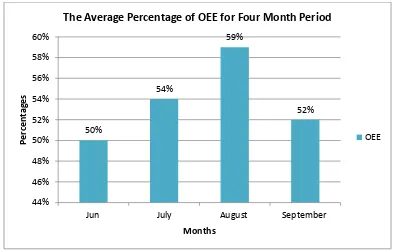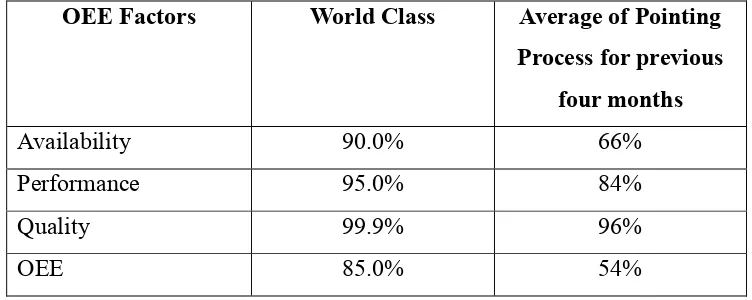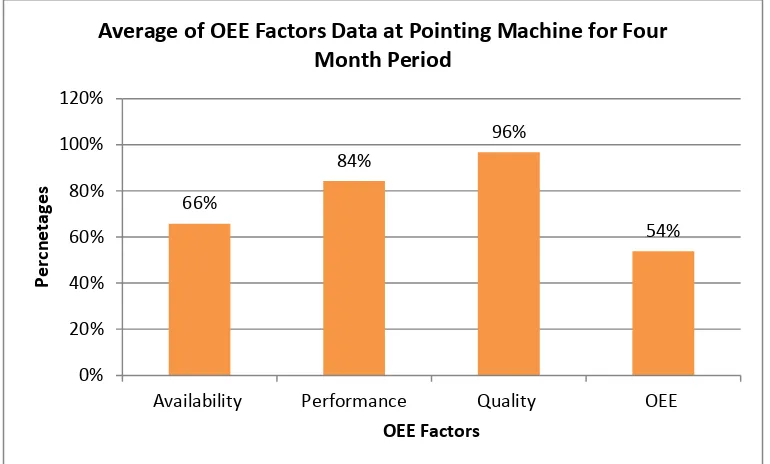PRODUCTIVITY ENHANCEMENT BY OVERALL
EQUIPMENT EFFECTIVENESS (OEE) IMPROVEMENT
IN HABERDASHERY INDUSTRY: A CASE STUDY
SITI AMIRAH BINTI MOHAMAD NOOR
B051210139
UNIVERSITI TEKNIKAL MALAYSIA MELAKA
PRODUCTIVITY ENHANCEMENT BY OVERALL
EQUIPMENT EFFECTIVENESS (OEE) IMPROVEMENT IN
HARBERDASHERY INDUSTRY: A CASE STUDY
This report submitted in accordance with requirement of the Universiti Teknikal Malaysia Melaka (UTeM) for the Bachelor Degree of Manufacturing Engineering
(Manufacturing Management (Hons.)
by
SITI AMIRAH BINTI MOHAMAD NOOR B051210139
910119-02-5938
UNIVERSITI TEKNIKAL MALAYSIA MELAKA
BORANG PENGESAHAN STATUS LAPORAN PROJEK SARJANA MUDA
TAJUK: Productivity Enhancement by Overall Equipment Effectiveness (OEE) Improvement in Haberdashery Industry
SESI PENGAJIAN: 2014/15 Semester 2
SayaSITI AMIRAH BINTI MOHAMAD NOOR
mengaku membenarkan Laporan PSM ini disimpan di Perpustakaan Universiti Teknikal Malaysia Melaka (UTeM) dengan syarat-syarat kegunaan seperti berikut: 1. Laporan PSM adalah hak milik Universiti Teknikal Malaysia Melaka dan penulis. 2. Perpustakaan Universiti Teknikal Malaysia Melaka dibenarkan membuat salinan
untuk tujuan pengajian sahaja dengan izin penulis.
3. Perpustakaan dibenarkan membuat salinan laporan PSM ini sebagai bahan pertukaran antara institusi pengajian tinggi.
4. **Sila tandakan ( )
SULIT
√
TERHAD
TIDAK TERHAD
(Mengandungi maklumat yang berdarjah keselamatan atau kepentingan Malaysia sebagaimana yang termaktub dalam AKTA RAHSIA RASMI 1972)
(Mengandungi maklumat TERHAD yang telah ditentukan oleh organisasi/badan di mana penyelidikan dijalankan)
Alamat Tetap:
No. 33G Kampung Batu Putih, 09700 Karangan Kulim,
I hereby, declared this report entitled “Productivity Enhancement by Overall Equipment Effectiveness (OEE) Improvement in Haberdashery Industry” is the
results of my own research except as cited in references.
Signature : ………
Author’s Name : ………
Date : ………
DECLARATION
This report is submitted to the Faculty of Manufacturing Engineering of UTeM as a partial fulfillment of the requirements for the degree of Bachelor of Manufacturing Engineering (Manufacturing Management) (Hons.). The member of the supervisory is as follow:
………
(Dr. Effendi Bin Mohamad)
i
Pada awal tahun 1990-an, Keberkesanan Peralatan Keseluruhan (OEE) telah dibatasi hanya sebagai alat pengukuran bagi Jumlah Penyelenggaraan Produktif (TPM), tetapi kini ia dilihat sebagai alat yang berasingan untuk mengukur prestasi sebenar pengeluaran di mana-mana jabatan atau organisasi. OEE adalah Metrik kuat pembuatan ukuran prestasi mengintegrasikan daripada penggunaan, hasil dan kecekapan proses, mesin pengeluaran garis yang diberi. Apabila dikaitkan dengan sebab-sebab bagi kehilangan prestasi, OEE menyediakan cara untuk membandingkan dan mengutamakan usaha penambahbaikan. Tujuan kajian penyelidikan ini adalah untuk membangunkan kaedah untuk meningkatkan OEE untuk Mesin Pointing di Jabatan Haberdashery dengan menggunakan Alat Lean. Berdasarkan analisis, faktor kehilangan Ketersediaan dikenalpasti dengan aktiviti yang tidak menambah nilai yang tinggi, dan dengan itu penambahbaikan dicadangkan. Peningkatan ini hanya memberi tumpuan kepada kerugian Ketersediaan dan tidak termasuk Prestasi dan Kualiti kerugian. Kaizen telah dilaksanakan untuk mengurangkan kerugian mesin tidak produktif berkenaan dengan masalah penetapan mesin. Set bulanan lengkap tali rata dibuat untuk mengatasi kekurangan peralatan di Jabatan Pointing. Selain itu, Prosedur Operasi Standard (SOP) bagi proses pencantuman tali rata cadangan untuk menyeragamkan kaedah yang betul. Peningkatan pada OEE dinilai berdasarkan keputusan pengurangan mesin downtime. Penambahbaikan membawa peningkatan dalam Ketersediaan dan OEE peratusan 13.63% dan 18.51%. Pengeluaran pada mesin meningkat apabila mesin berhenti dapat dikurangkan, sekaligus peningkatan pada produktiviti dapat dicapai.
ii
In the early 1990s, Overall Equipment Effectiveness (OEE) was regarded only as measurement tool for Total Productive Maintenance (TPM), but now it is viewed as a separate tool for measuring true production performance in a department or organization. OEE is a powerful metric of manufacturing performance integrating measures of the utilisation, yield and efficiency of a given process, machine or manufacturing line. When associated with the reasons for performance loss, OEE provides the means to compare and prioritise improvement efforts. The purpose of this research study is to develop the methodology to improve the OEE for the Pointing Machine at Haberdashery Department by using the Lean Manufacturing Tools. The productivity losses based on previous OEE were studied to identify factors contributing to the unfavourable performance of the machine. Based on the analysis, the Availability loss factor is identified with the highest non-value added activities and thus improvements are proposed. The improvement only focuses on Availability loss and not including Performance and Quality losses. Kaizen was implemented to reduce the machine downtime losses with regard to the machine setting problem. The monthly complete set of belt is made to overcome the lack of equipment at Pointing Department. Besides, the Standard Operating Procedure (SOP) for joining process of belt proposed to standardize the proper method. Improvement on the OEE is evaluated based on the results of machine downtime reduction. The improvements bring out an increase in the Availability and OEE percentages of 13.63% and18.51% respectively. The output of the machine increases when the machine downtime is reduced, therefore an enhancement of productivity can be achieved.
iii
This project is dedicated to my parents who have never failed to give me financial and moral support, for teaching me that even the largest task can be accomplished if it is
done one step at a time.
iv
Firstly, I would like to express my gratefulness to Allah S.W.T for giving me strength and wisdom to finish my final year project. I also would like to express my gratitude to the following individuals for providing me the inspiration and help.
My deepest thank go to my supervisor, Dr. Effendi Bin Mohamad for help, motivation and precious advise. His constructive comments were vital to the development of this study.
Here, I thank my parents for helping me throughout the project and providing a financial support until I successfully completed this study. Their undivided love and support are the beacons that have continued to motivate me through the harshest of situations.
I also thank all my friends for their continuing encouragement and support. I am gratefully expressing my thanks to all my lecturers, friend and many other personnel I have spoken with about this study for sharing their helpfulness, ideas and kindness.
Last but not least, I wish to acknowledge to all persons who give supporting, advice, and assistance that are directly or indirectly involved to the success of my study. Thank you so much.
v
List Of Abbreviation, Symbols And Nomenclature xiv
CHAPTER 1: INTRODUCTION 1
1.1 Background of Study 1
1.2 Problem Statement 3
1.3 Objective of Study 4
1.4 Scope of Study 4
1.5 Project Summary 5
CHAPTER 2: LITERATURE REVIEW 7
vi
CHAPTER 3: METHODOLOGY 23
3.1 Overview of the Methodology 23
vii
3.2.2.4 Failure Mode and Effect Analysis (FMEA) Technique
CHAPTER 4: RESULT AND DISCUSSION 38
4.1 Introduction of Company Background 38
4.1.1 Haberdashery Division Manufacturing 38
4.1.1.1 Machine 40
4.2.2.5 Identify the OEE Factors Losses 51 4.2.3 The Reason of the Machine Breakdown in Pointing
4.2.3.5 Average Data of Downtime Machine for Month Period
viii 4.4.1.2 Current Method on Belt Joining Process: Thermofix
Joining
69
4.4.1.3 Flat Belt Problem 70
4.4.1.4 Frequency of the Broken Belt for a Month 70 4.4.1.5 Different Number of Belts Size Involved 71
4.4.2 Data Evaluation 72
4.4.2.1 Suggested Solution of Flat Belt Problem 72 4.4.2.2 The New Process Flow of Belt to be Replaced 73 4.5.3.1 Productivity Increase Calculation 86
CHAPTER 5: CONCLUSION AND RECOMMENDATION 87
5.1 Conclusion 87
ix REFERENCES
89
APPENDICES A: Project Picture B: Gantt Chart
C: FMEA Rating Scale
x
1.1 Comparison of World Class OEE Factor and Pointing Process Factor for Previous Five Months
3
2.1 LM Tools and Techniques 14
2.2 OEE Machine Loss 20
2.3 The Six Big Losses that Relate to Losses in OEE 21 3.1 The steps of SOP development to assemble the new belt 37
4.1 Low Frame Machine Part and Functions 42
4.2 The production output, downtime and scrap data for Machine G9
4.8 The Total Average Data of Availability, Performance, Quality and OEE for Four Months Period
53
4.9 The Frequency of Downtime Machine Occurrences based on certain Reason for Line G from Jun to September
54
4.10 The Frequency of Downtime Machine Occurrences based on certain Reason for Line H from Jun to September
55
4.11 The Frequency of Downtime Machine Occurrences based on certain Reason for Line I from Jun to September
57
4.12 The Frequency of Downtime Machine Occurrences based on certain Reason for Line J from Jun to September
58
xi
4.13 FMEA of Long Processing Lead Time for Flat Belt Replacement
65
4.14 The procedure to fix the new belt 68
4.15 The materials and equipment that use for belt joining process 69
4.16 The Problem and Causes of Belt Not Durable 70
4.17 Frequency of the broken belt for one month 70
4.18 Length of belt (1) for Low Frame Machine 71
4.19 Length of belt (3) for Low Frame Machine 71
4.20 Suggested solution related to flat belt problem 72
4.21 Current PM of Pointing Machine 76
4.22 Upgrading the Current PM of Pointing Machine 77 4.23 The OEE Data of Line G, Line H, Line I, Line J for two month
4.27 The production output, downtime and scrap data for Machine G9
82
4.28 Comparison of OEE and Availability data after implementing Kaizen
xii
1.1 Percentage OEE of Machine Line G for Previous Five Months 2 1.2 Average of OEE Factors Data for Four Month Period 4
3.1 The Flow Chart of Process Planning 24
3.2 Bar Chart 27
3.8 Failure Mode and Effects Analysis (FMEA) Techniques 32
3.9 Grouped Bar Chart 33
4.1 Pointing Department Location 39
4.2 Pointing Department 39
4.3 Low Frame Pointing Machine 40
4.4 Pointing Stem 42
4.5 Process flow of stem production 43
4.6 Hard Steel Wire 43
4.7 Mild Steel Wire 44
4.8 Stainless Steel Wire 44
4.9 Brass Wire 44
4.10 General Information of OEE Data at Pointing Department 45 4.11 The Average of OEE Data for Four Month Period 48 4.12 The Average of Availability Data for Four Month Period 49 4.13 The Average of Performance Data for Four Month Period 50 4.14 The Average of Quality Data for Four Month Period 51 4.15 The Total Average of Availability, Performance, Quality and
OEE Data
52
xiii
4.16 The Percentages of Downtime Machine Reason for Line G 53 4.17 The Percentages of Downtime Machine Reason for Line H 55 4.18 The Percentages of Downtime Machine Reason for Line I 56 4.19 The Percentages of Downtime Machine Reason for Line J 57 4.20 The Average Percentages of Downtime Machine Reason for
All Line
58
4.21 Pareto Diagram for Downtime Machine Reason 59
4.22 Brainstorming of Machine Setting Problem at Pointing Department
60
4.23 Mill Belt 1 and 3 for Pointing Machine 61
4.24 Spinner Blade Problem 62
4.25 Wire Swing 62
4.26 Why Why why analysis diagram 63
4.27 Pareto Diagram of Broken Flat Belt 64
4.28 The process flow of belt to be replaced 67
4.29 Thermofix joining system 67
4.30 Processing Lead Time for Flat Belt Replacement 73
4.31 The Flow Chart of Operating Procedure 74
4.32 The Average of OEE Data Two Month Period 79
4.33 The Availability of OEE Data Two Month Period 80 4.34 The Performance of OEE Data Two Month Period 80 4.35 The Average of Quality Data Two Month Period 81 4.36 General Information of OEE Data at Pointing Department 82 4.37 Comparison of OEE and Availability data after implementing
Kaizen
xiv
MIDA - Malaysian Industrial Development Authority TPM - Total Preventive Maintenance
OEE - Overall Equipment Effectiveness
VSM - Value Stream Mapping
WIP - Work in Process
AMO - Autonomous Maintenance Program
SPC - Process Control
SMED - Single Minute Exchange of Die
MIDA - Malaysian Industrial Development Authority TPM - Total Preventive Maintenance
OEE - Overall Equipment Effectiveness FMEA - Failure Mode Effects Analysis SOP - Standard Operation Procedure
QC - Quality Control
PM - Preventive Maintenances
1
Chapter 1 of this report will give a concise introduction on the study conducted that contains the background of the problem statement, the objectives to be achieved throughout the project and the scope of the study which clearly defined the boundaries or limit of this study. This chapter also provides a structure of the report which generally describes about chapter division and related contents to that particular chapter. All in all, it summarizes the progress of the whole project, including how the whole project has been carried out.
1.1 Background of Study
Malaysian Industrial Development Authority (MIDA, 2012) state that the largest economic in Malaysia is manufacturing by contributing 32% of overall economic and specifically 79% of the total export compared to other sectors. For the better economic achievement courses in Malaysia, more focuses and attention should be given for the industry to further improve the development.
The elimination of seven most critical wastes is frequently related to lean manufacturing. It is intricate the effects of changeability in demand, supply or processing time. Nakajima (1988) had launched Total Preventive Maintenance (TPM) concept and had offered the measureable metric of Overall Equipment Effectiveness (OEE) to determine the productivity of particular machine.
INTRODUCTION
2
The study is carried out in a Haberdashery Industry. The Research Company is one of the manufacturing industries which have implemented TPM in their operation system. Since it was launched in April 2014, the Research Company still has to face of many challenges in order to maintain the TPM programme. This company is still looking for the best way to improve the implementation of TPM in order to achieve their objective to be successful company that implements this programme.
Figure 1.1: The Average Percentage of OEE for Four Month Period
Figure above shows the average of OEE percentage (%) for four months period from Jun to September. The graph indicated unprogressive OEE% of Pointing Machine for Line G, H, I and J. Lean manufacturing is the techniques and process being implemented by companies around the world that intent to reduce unneeded and unproductive tasks, activities and attitude in the work environment. In additional, lean manufacturing is a complete procedure in order to reduce waste and improve the organization production and morale. There are many tools and techniques in lean manufacturing that can be
The Average Percentage of OEE for Four Month Period
3
1.2 Problem Statement
The prior data of OEE of Research Company is unsatisfactory compared to the general manufacturing framework. The OEE stands at an average of 50% to 60% where else benchmark of world class OEE rating is at least 85%. The table below is the example of the OEE% for Pointing Machine for previous five months.
Table 1.1: Comparison of World Class OEE Factor and Pointing Process Factor for Four Month Period
OEE Factors World Class Average of Pointing Process for previous
According to the comparison of world class factor and average of pointing process factor for previous for four months, availability is 66%, performance is 84% and quality is 96%. The achieved result shows distance between both factors. The major reason for the distance is availability factor level in this process. In other to improve the OEE for pointing process, we need to enhance the availability of factor level.
The OEE tools are used to evaluate performance and productivity of the machine. Figure 1.1 shows the OEE of pointing process with 54%. There are three main time losses which are downtime loss (availability), speed loss (performance) and quality loss (quality) with 66%, 84% and 96% respectively. There are the several possible causes of this condition:
a. The time lost due to key equipment breaking down which causes the production to be stopped for more than 10 minutes
4
Figure 1.2: Average of OEE Factors Data for Four Month Period
OEE is fundamentally a tool that helps manufacturing companies improve their core by reduction of costs, enhancing quality, and enhancing productivity Moreover, OEE is part of a continuous improvement approach that supports of the manufacturing process through employee involvement and authorization. Nakajima (1988) stated that, OEE measurement is a powerful way of analyzing the efficiency of the individual machine. It is an operation of availability rate, performance rate and quality rate where to measure of the equipment losses.
1.3 Objectives of Study
The objectives of this study are:
1. To identify the productivity losses based on the previous OEE in Haberdashery Industry at Pointing Machine Line.
2. To maximize the availability of equipment by minimizing breakdowns and setup time through Lean Tools.
5
1.4 Scope of Study
This study mainly focuses on the improvement of OEE of the pointing machine in Research Company through Lean Tools. The prosecution of this study only covers on pointing machine in Research Company. The scope of this study starts from the validation the productivity losses based on the current Overall Equipment Effectiveness at the Pointing Machine Line. Next, the OEE data on machine performance is an initial key point to identify the equipment losses and establish improvement to eliminate them. The study also includes the conduct of future state analysis for the purpose of evaluating the percentage of OEE improvement based on the operating time to enhance productivity. Improvement of performance and quality is not in the scope of this study.
1.5 Project Summary
For ease to read and comprehension, this report is written by following and according the arrangement of chapter which have been decided. This report is divided into five major parts, which is each of them consist different explanation according to the chapter. Chapter 1: Introduction
This chapter clarifies about the background of study, problem statement, objectives and the scope of the study which acts as the core to the entire research and study.
Chapter 2: Literature Review
This chapter covers on the literature review conducted to ease the understanding of relevant topics for this study through research of all types of published work.
Chapter 3: Methodology


